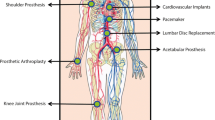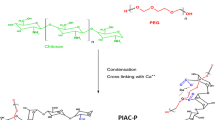Abstract
The controlled release of therapeutics from microparticles or nanoparticles (NPs) has been well-studied. Incorporation of these particles inside biomaterial scaffolds is promising for tissue regeneration and immune modulation. However, these particles may induce inflammatory and foreign body responses to scaffold constructs, limiting their applications. Here we show that widely used poly(lactic-co-glycolic acid) nanoparticles (PLGA NPs) formed by double emulsion dramatically increased neutrophil infiltration and pro-inflammatory cytokines in alginate scaffolds 1 day after the subcutaneous injection of the scaffolds into mice. The coating of red blood cell (RBC) membranes on PLGA NPs completely eliminated these short-term inflammatory responses. For a longer term of 10 days, neither PLGA NPs nor RBC membrane-coated NPs exerted a significant effect on the infiltration of neutrophils or macrophages in alginate scaffolds, possibly due to the degradation and/or clearance of NPs by infiltrating cells. Despite the extensive exploration of cell membrane-coated NPs, our study is the first to investigate the effects of cell membrane coating on foreign body reaction to NPs. By harnessing the natural biocompatibility of cell membranes, our strategy of anti-inflammatory protection for scaffolds may be pivotal for many applications such as those relying on the recruitment of stem cells and/or progenitor cells to scaffolds.
Similar content being viewed by others
References
Teng, Y. D.; Lavik, E. B.; Qu, X. L.; Park, K. I.; Ourednik, J.; Zurakowski, D.; Langer, R.; Snyder, E. Y. Functional recovery following traumatic spinal cord injury mediated by a unique polymer scaffold seeded with neural stem cells. Proc. Natl. Acad. Sci. USA 2002, 99, 3024–3029.
Li, W. J.; Tuli, R.; Okafor, C.; Derfoul, A.; Danielson, K. G.; Hall, D. J.; Tuan, R. S. A three-dimensional nanofibrous scaffold for cartilage tissue engineering using human mesenchymal stem cells. Biomaterials 2005, 26, 599–609.
Ali, O. A.; Huebsch, N.; Cao, L.; Dranoff, G.; Mooney, D. J. Infection-mimicking materials to program dendritic cells in situ. Nat. Mater. 2009, 8, 151–158.
Sheridan, M. H.; Shea, L. D.; Peters, M. C.; Mooney, D. J. Bioabsorbable polymer scaffolds for tissue engineering capable of sustained growth factor delivery. J. Control. Release 2000, 64, 91–102.
Lee, K. Y.; Peters, M. C.; Anderson, K. W.; Mooney, D. J. Controlled growth factor release from synthetic extracellular matrices. Nature 2000, 408, 998–1000.
Lutolf, M. R.; Weber, F. E.; Schmoekel, H. G.; Schense, J. C.; Kohler, T.; Müller, R.; Hubbell, J. A. Repair of bone defects using synthetic mimetics of collagenous extracellular matrices. Nat. Biotechnol. 2003, 21, 513–518.
Elbert, D. L.; Pratt, A. B.; Lutolf, M. P.; Halstenberg, S.; Hubbell, J. A. Protein delivery from materials formed by self-selective conjugate addition reactions. J. Control. Release 2001, 76, 11–25.
Seliktar, D.; Zisch, A. H.; Lutolf, M. P.; Wrana, J. L.; Hubbell, J. A. MMP-2 sensitive, VEGF-bearing bioactive hydrogels for promotion of vascular healing. J. Biomed. Mater. Res. A 2004, 68, 704–716.
Martino, M. M.; Briquez, P. S.; Ranga, A.; Lutolf, M. P.; Hubbell, J. A. Heparin-binding domain of fibrin(ogen) binds growth factors and promotes tissue repair when incorporated within a synthetic matrix. Proc. Natl. Acad. Sci. USA 2013, 110, 4563–4568.
Purcell, B. P.; Lobb, D.; Charati, M. B.; Dorsey, S. M.; Wade, R. J.; Zellars, K. N.; Doviak, H.; Pettaway, S.; Logdon, C. B.; Shuman, J. A. et al. Injectable and bioresponsive hydrogels for on-demand matrix metalloproteinase inhibition. Nat. Mater. 2014, 13, 653–661.
Richardson, T. P.; Peters, M. C.; Ennett, A. B.; Mooney, D. J. Polymeric system for dual growth factor delivery. Nat. Biotechnol. 2001, 19, 1029–1034.
Li, S. R.; Nih, L. R.; Bachman, H.; Fei, P.; Li, Y. L.; Nam, E.; Dimatteo, R.; Carmichael, S. T.; Barker, T. H.; Segura, T. Hydrogels with precisely controlled integrin activation dictate vascular patterning and permeability. Nat. Mater. 2017, 16, 953–961.
Vacanti, N. M.; Cheng, H.; Hill, P. S.; Guerreiro, J. D. T.; Dang, T. T.; Ma, M. L.; Watson, S.; Hwang, N. S.; Langer, R.; Anderson, D. G. Localized delivery of dexamethasone from electrospun fibers reduces the foreign body response. Biomacromolecules 2012, 13, 3031–3038.
Tan, Q.; Tang, H.; Hu, J. G.; Hu, Y. R.; Zhou, X. M.; Tao, Y. M.; Wu, Z. S. Controlled release of chitosan/heparin nanoparticle-delivered VEGF enhances regeneration of decellularized tissue-engineered scaffolds. Int. J. Nanomed. 2011, 6, 929–942.
Holland, T. A.; Bodde, E. W. H.; Cuijpers, V. M. J. I.; Baggett, L. S.; Tabata, Y.; Mikos, A. G.; Jansen, J. A. Degradable hydrogel scaffolds for in vivo delivery of single and dual growth factors in cartilage repair. Osteoarthritis Cartilage 2007, 15, 187–197.
Hosseinkhani, H.; Hosseinkhani, M.; Gabrielson, N. P.; Pack, D. W.; Khademhosseini, A.; Kobayashi, H. DNA nanoparticles encapsulated in 3D tissue-engineered scaffolds enhance osteogenic differentiation of mesenchymal stem cells. J. Biomed. Mater. Res. A 2008, 85, 47–60.
Hedberg, E. L.; Tang, A.; Crowther, R. S.; Carney, D. H.; Mikos, A. G. Controlled release of an osteogenic peptide from injectable biodegradable polymeric composites. J. Control. Release 2002, 84, 137–150.
Verbeke, C. S.; Gordo, S.; Schubert, D. A.; Lewin, S. A.; Desai, R. M.; Dobbins, J.; Wucherpfennig, K. W.; Mooney, D. J. Multicomponent injectable hydrogels for antigenspecific tolerogenic immune modulation. Adv. Healthc. Mater. 2017, 6, 1600773.
Gurtner, G. C.; Werner, S.; Barrandon, Y.; Longaker, M. T. Wound repair and regeneration. Nature 2008, 453, 314–321.
Anderson, J. M.; Rodriguez, A.; Chang, D. T. Foreign body reaction to biomaterials. Semin. Immunol. 2008, 20, 86–100.
Anderson, J. M. Biological responses to materials. Ann. Rev. Mater. Res. 2001, 31, 81–110.
Anderson, J. M.; McNally, A. K. Biocompatibility of implants: Lymphocyte/macrophage interactions. Semin. Immunopathol. 2011, 33, 221–233.
Kim, Y. K.; Chen, E. Y.; Liu, W. F. Biomolecular strategies to modulate the macrophage response to implanted materials. J. Mater. Chem. B 2016, 4, 1600–1609.
Zhang, L.; Cao, Z. Q.; Bai, T.; Carr, L.; Ella-Menye, J. R.; Irvin, C.; Ratner, B. D.; Jiang, S. Y. Zwitterionic hydrogels implanted in mice resist the foreign-body reaction. Nat. Biotechnol. 2013, 31, 553–556.
Vegas, A. J.; Veiseh, O.; Doloff, J. C.; Ma, M. L.; Tam, H. H.; Bratlie, K.; Li, J.; Bader, A. R.; Langan, E.; Olejnik, K. et al. Combinatorial hydrogel library enables identification of materials that mitigate the foreign body response in primates. Nat. Biotechnol. 2016, 34, 345–352.
Chen, E. Y.; Chu, S. H.; Gov, L.; Kim, Y. K.; Lodoen, M. B.; Tenner, A. J.; Liu, W. F. CD200 modulates macrophage cytokine secretion and phagocytosis in response to poly(lacticco-glycolic acid) microparticles and films. J. Mat. Chem. B 2017, 5, 1574–1584.
Wu, Y. Q.; Qu, H. C.; Sfyroera, G.; Tzekou, A.; Kay, B. K.; Nilsson, B.; Ekdahl, K. N.; Ricklin, D.; Lambris, J. D. Correction: Protection of nonself surfaces from complement attack by factor H-binding peptides: Implications for therapeutic medicine. J. Immunol. 2012, 188, 6425.
Hu, C. M. J.; Zhang, L.; Aryal, S.; Cheung, C.; Fang, R. H.; Zhang, L. F. Erythrocyte membrane-camouflaged polymeric nanoparticles as a biomimetic delivery platform. Proc. Natl. Acad. Sci. USA 2011, 108, 10980–10985.
Hu, C. M. J.; Fang, R. H.; Wang, K. C.; Luk, B. T.; Thamphiwatana, S.; Dehaini, D.; Nguyen, P.; Angsantikul, P.; Wen, C. H.; Kroll, A. V. et al. Nanoparticle biointerfacing by platelet membrane cloaking. Nature 2015, 526, 118–121.
Hu, Q. Y.; Sun, W. J.; Qian, C. G.; Wang, C.; Bomba, H. N.; Gu, Z. Anticancer platelet-mimicking nanovehicles. Adv. Mater. 2015, 27, 7043–7050.
Gao, M.; Liang, C.; Song, X. J.; Chen, Q.; Jin, Q. T.; Wang, C.; Liu, Z. Erythrocyte-membrane-enveloped perfluorocarbon as nanoscale artificial red blood cells to relieve tumor hypoxia and enhance cancer radiotherapy. Adv. Mater. 2017, 29, 1701429.
Fan, Z. Y.; Zhou, H.; Li, P. Y.; Speer, J. E.; Cheng, H. Structural elucidation of cell membrane-derived nanoparticles using molecular probes. J. Mater. Chem. B 2014, 2, 8231–8238.
Zhou, H.; Fan, Z. Y.; Lemons, P. K.; Cheng, H. A facile approach to functionalize cell membrane-coated nanoparticles. Theranostics 2016, 6, 1012–1022.
Fang, R. H.; Hu, C. M. J.; Luk, B. T.; Gao, W. W.; Copp, J. A.; Tai, Y. Y.; O'Connor, D. E.; Zhang, L. F. Cancer cell membrane-coated nanoparticles for anticancer vaccination and drug delivery. Nano Lett. 2014, 14, 2181–2188.
Xuan, M. J.; Shao, J. X.; Zhao, J.; Li, Q.; Dai, L. R.; Li, J. B. Magnetic mesoporous silica nanoparticles cloaked by red blood cell membranes: Applications in cancer therapy. Angew. Chem., Int. Ed., in press, DOI: 10.1002/anie.201712996.
Li, P. Y.; Fan, Z. Y.; Cheng, H. Cell membrane bioconjugation and membrane-derived nanomaterials for immunotherapy. Bioconjug. Chem. 2018, 29, 624–634.
Fang, R. H.; Kroll, A. V.; Gao, W. W.; Zhang, L. F. Cell membrane coating nanotechnology. Adv. Mater., in press, DOI: 10.1002/adma.201706759.
Oldenborg, P. A.; Zheleznyak, A.; Fang, Y. F.; Lagenaur, C. F.; Gresham, H. D.; Lindberg, F. P. Role of CD47 as a marker of self on red blood cells. Science 2000, 288, 2051–2054.
Bencherif, S. A.; Sands, R. W.; Bhatta, D.; Arany, P.; Verbeke, C. S.; Edwards, D. A.; Mooney, D. J. Injectable preformed scaffolds with shape-memory properties. Proc. Natl. Acad. Sci. USA 2012, 109, 19590–19595.
Copp, J. A.; Fang, R. H.; Luk, B. T.; Hu, C. M. J.; Gao, W. W.; Zhang, K.; Zhang, L. F. Clearance of pathological antibodies using biomimetic nanoparticles. Proc. Natl. Acad. Sci. USA 2014, 111, 13481–13486.
Acknowledgements
Research reported in this publication was supported by a faculty startup fund from Drexel University to H. C., a pilot grant from the Clinical & Translational Research Institute (CTRI), and National Institute of Allergy and Infectious Diseases of the National Institutes of Health under Award Number R21AI133372. We would like to thank Dr. Elizabeth Blankenhorn and Dr. Frank Bearoff for their help on real-time PCR analysis.
Author information
Authors and Affiliations
Corresponding author
Rights and permissions
About this article
Cite this article
Fan, Z., Li, P.Y., Deng, J. et al. Cell membrane coating for reducing nanoparticle-induced inflammatory responses to scaffold constructs. Nano Res. 11, 5573–5583 (2018). https://doi.org/10.1007/s12274-018-2084-y
Received:
Revised:
Accepted:
Published:
Issue Date:
DOI: https://doi.org/10.1007/s12274-018-2084-y




